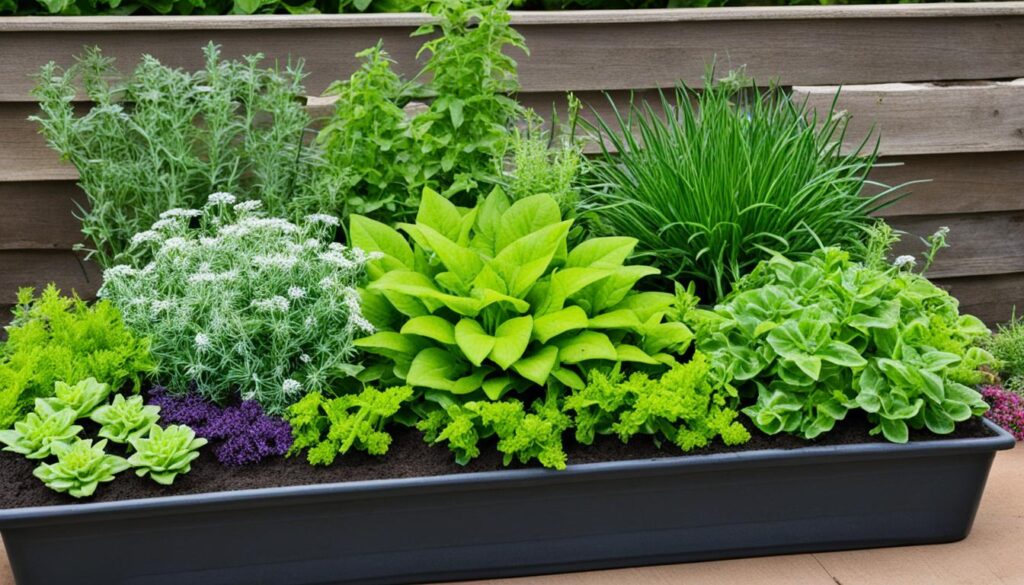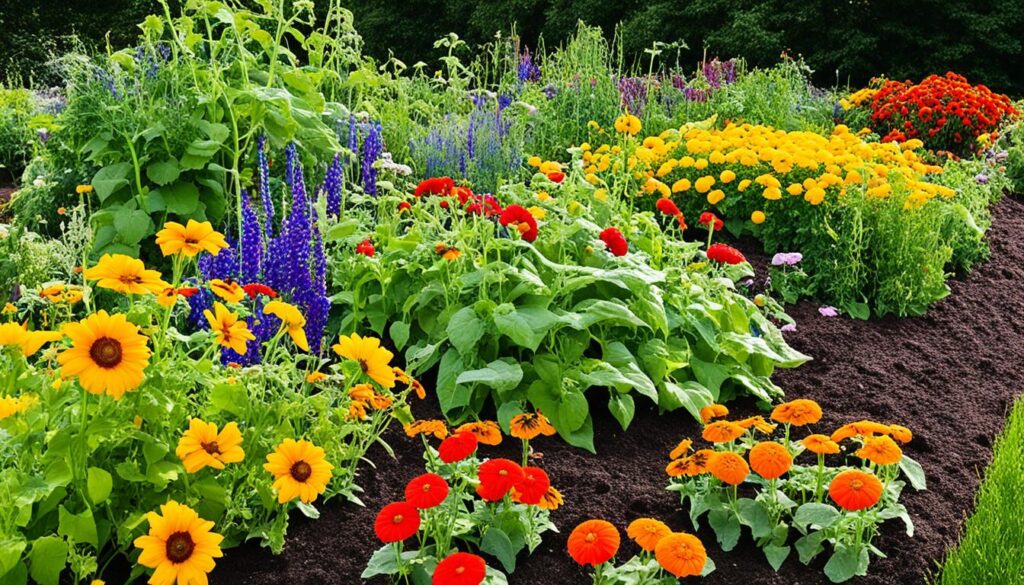Top Companion Plant Pairs Every Gardener Should Know
Ever wondered what makes a garden pest-free and thriving? The secret might be in companion planting. But what is it, and how does it boost your gardening success? Learn about the top plant pairs that work together for a harmonious garden.
Key Takeaways
- Companion planting is the strategic pairing of plants that mutually benefit each other
- Certain plant combinations can deter pests, improve soil health, and increase yields
- Knowing the best companion plant pairs can help you create a thriving, low-maintenance garden
- Incorporating flowers and herbs alongside your vegetables can attract pollinators and beneficial insects
- Understanding the science behind companion planting can help you make informed decisions for your garden
What Is Companion Planting?
Companion planting means growing different plants together for mutual benefits. By picking the right plants to grow together, you create a garden that thrives. This method combines ancient farming wisdom with modern science.
Understanding the Benefits of Growing Plants Together
When you practice companion planting, you use the natural strengths of plants. Some plants offer shade or support, while others keep pests away or improve soil. This creates a garden that helps each plant grow better.
- Increased pest resistance through natural pest deterrents
- Enhanced soil fertility from nitrogen-fixing plants or those that attract beneficial insects
- Improved pollination from nectar-rich flowers that attract pollinators
- Greater overall plant health and productivity
Proven Examples of Successful Companion Planting
The Three Sisters method, with corn, beans, and squash, is a classic example. Corn supports the beans, beans enrich the soil, and squash keeps weeds down. This trio shows how plants can work together well.
“Companion planting is nature’s way of minimizing pest damage, boosting soil fertility, reducing weed competition, and, ultimately, increasing yields.”
Evidence-Based Companion Planting Philosophy
Companion planting has grown a lot in recent years. It’s moved from old stories to solid science. Now, thanks to scientific companion planting research, we know which plants work well together.
Before, people thought some veggies had special friends and enemies. But new studies have shown this isn’t always true. They’ve dispelled companion planting myths. Now, we see how plants help each other when grown together.
“The bottom line is that there is simply more evidence for ‘good’ companions than ‘bad’ ones, so the focus is now more on why vegetables need friends.”
Studies show that most plant pairs help each other out. They improve pest control, make nutrients available, and attract pollinators. This proves the benefits of choosing the right evidence-backed plant pairings.
With this evidence-based companion planting philosophy, gardeners can plan their gardens with confidence. They know their plants will grow well together. It’s an exciting time for gardening!
Examples of the Best Companion Plants
Companion planting can greatly benefit your garden. It helps with pest control, plant health, and flavor. Let’s look at some top pairings for your garden.
Basil and Tomatoes: A Classic Combo
Basil and tomatoes are perfect together. Basil keeps away thrips and moths that harm tomatoes. It also brings in bees, which helps pollinate and taste better.
Dill: Attracting Ladybugs to Control Pests
Dill is great for attracting ladybugs. These bugs eat pests like aphids and spider mites. Adding dill near your veggies uses these helpful insects to protect your plants.
Other great beneficial plant pairings include:
- Borage goes well with tomatoes, drawing in bees and making strawberries taste and grow better.
- Garlic and garlic spray keep pests away with their strong smell.
- Mint keeps aphids, ants, and flea beetles away, making it a top choice for pest control.
- Nasturtiums draw caterpillars away from cabbage, broccoli, and kale.
- Parsley brings in beneficial insects to protect and pollinate tomatoes.
Using these successful companion planting examples in your garden creates a healthy, balanced environment. Your plants will thrive and be more productive.
The Science Behind Companion Planting
The study of companion planting is a deep dive into how plants interact with insects and each other. Scientists have found out why some plants work well together. They’ve uncovered the secrets of nature’s clever designs.
Take radishes and pumpkins, for example. When grown together, radishes keep away the squash bug from pumpkins. This happens because radishes release chemicals that pumpkins can absorb. These chemicals protect pumpkins from pests.
Tomatoes and basil are another great pair. Basil’s scent hides the tomatoes from pests. This shows how plants can work together using chemistry.
Leaf shape and arrangement matter too. A mix of leaves can confuse pests, making it hard for them to find their target plant. This helps protect the plant from being eaten.
| Companion Plant Pairing | Scientific Explanation |
|---|---|
| Radishes and Pumpkins | Radishes secrete water-soluble glucosinolates that can be absorbed by pumpkin plants, providing them with natural pest deterrence. |
| Tomatoes and Basil | Basil’s strong aroma helps to disguise the presence of tomato plants, making it harder for pests to locate their desired target. |
| Diverse Leaf Arrangements | A confusing array of leaves can effectively conceal a plant from its would-be predators, as pests may struggle to recognize their host amidst the melee of foliage. |
Studies on companion planting, plant-insect relationships, and plant biochemistry and pest deterrence have given us new insights. They show how plants can help each other grow strong and pest-free. By using these principles, gardeners can create gardens that are full of life and pests.
top companion plant pairs
Companion planting is key to a successful garden. By pairing certain plants, you create a balanced garden. This helps both your veggies and flowers grow well. Let’s look at some top pairings every gardener should know.
Vegetables and Herbs: Tried-and-True Combinations
Basil and tomatoes make a classic pair. Basil improves tomato flavor and keeps pests away. Dill and cucumbers are another great pair. Dill attracts ladybugs that eat aphids, keeping cucumbers healthy.
Flowers and Pollinators: A Mutually Beneficial Relationship
Adding flowers to your garden attracts pollinators and boosts plant health. Flowers like zinnias, cosmos, and marigolds draw bees and butterflies. This flower-pollinator companion plant relationship helps pollinate your veggies and makes your garden lively.
“Companion planting is a time-honored tradition that can transform your garden into a thriving, self-sustaining oasis.”
Common Mistakes in Companion Planting
Companion planting can change the game in the garden, but it has its challenges. Both new and seasoned gardeners need to watch out for common companion planting pitfalls. One big mistake is not thinking about how plants grow. Planting tall crops near short ones can block sunlight and compete for resources.
Another mistake is pairing incompatible plant combinations. Some plants do well together, but others can harm each other. For example, some plants release chemicals that stop nearby plants from growing well.
- Failing to keep plants at the right distance from each other
- Mixing plants with different water and nutrient needs
- Not checking which plants are good “companions”
“The key to successful companion planting is understanding the unique growth habits and requirements of each plant species you wish to grow together.”
By looking into successful plant pairings and considering plant growth habits, gardeners can dodge common mistakes. This way, they can enjoy the benefits of this rewarding gardening method.

Companion Planting for Pest and Disease Control
Companion planting is a natural way to fight pests and diseases in your garden. Many herbs and flowers have scents or properties that keep pests away. They also draw in beneficial insects that eat pests.
Using Herbs to Repel Pests and Attract Beneficials
Herbs like garlic, mint, and marigolds have strong smells that pests don’t like. Planting these near your veggies can keep pests away. This helps protect your plants.
Some herbs and flowers also bring in good bugs that eat pests. For instance, dill and borage attract ladybugs and other insects that eat aphids and other pests.
| Herb | Pest Repellent | Beneficial Insect Attractor |
|---|---|---|
| Garlic | Aphids, beetles, rodents | – |
| Mint | Aphids, ants, cabbage worms | – |
| Marigolds | Nematodes, aphids, beetles | – |
| Dill | – | Ladybugs, lacewings |
| Borage | – | Bees, lacewings |
By adding these companion plants for pest management to your garden, you make a balanced ecosystem. This approach naturally keeps pests away and brings in beneficial insects. It makes your garden healthier and more sustainable.
“Companion planting is all about creating a diverse, self-sustaining garden ecosystem that works in harmony to control pests and diseases naturally.”
Incorporating Flowers into Your Vegetable Garden
Adding flowers as companion plants to your vegetable garden brings many benefits. They make your garden look great and help keep pests away. Pollinator-attracting flowers like nasturtiums, marigolds, and zinnias draw in good insects that eat garden pests.
When picking flowers for companion planting, think about when they bloom, how much sun and water they need, and how big they get. This way, your flowers and vegetables will work well together. They’ll make your garden a healthy, diverse place.
Flowers for Pest Control and Pollination
- Marigolds keep pests like aphids, nematodes, and rabbits away. They’re a great ornamental for pest control.
- Nasturtiums draw in ladybugs and lacewings. These insects eat aphids and other pests.
- Zinnias are easy to care for and pollinators love them. They help pollinate your vegetables.
By adding different kinds of pollinator-attracting flowers to your garden, you make a great place for your plants and local wildlife.

“A well-designed flower border can be both beautiful and functional, providing valuable habitat and resources for beneficial insects while enhancing the overall health and productivity of your vegetable garden.”
Bad Neighbors: Plants to Avoid Planting Together
Companion planting pairs plants to work well together in the garden. But, some plants don’t get along and should be kept apart. Knowing which plants clash is key to a healthy garden.
One big reason to keep some plants apart is they compete for things like nutrients and sunlight. Plants that fight over these resources shouldn’t be planted together. For instance, zucchini and winter squash vines can overshadow lettuce, making it hard for the lettuce to grow.
It’s also smart to keep plants that get the same diseases apart. This stops one sick plant from spreading its illness to others. So, tomatoes and potatoes shouldn’t be side by side since they can both get the same fungal diseases.
| Incompatible Plant Combinations | Reason for Avoiding |
|---|---|
| Zucchini or Winter Squash vs. Lettuce | Competition for resources (nutrients, water, space, sunlight) |
| Tomatoes vs. Potatoes | Susceptibility to the same diseases (e.g., fungal infections) |
| Brassicas (Cabbage, Broccoli, Cauliflower) vs. Tomatoes | Allelopathic effects (release of chemicals that inhibit growth of other plants) |
By knowing which plants don’t mix well, gardeners can grow a garden that’s full of life and productivity. This way, they make the most of planting together while avoiding problems with plant relationships.
Conclusion
Companion planting is a key gardening method that makes your garden better. It pairs plants together to keep pests away, improve soil, and draw in helpful insects. This approach boosts your garden’s productivity and looks.
It doesn’t matter if you’re growing veggies, herbs, or flowers. Using companion planting leads to more food and a healthier garden. You can try pairing basil with tomatoes or find new ones to see what works best.
Every garden is different, so try out various plant combinations. Watch how they interact and change things as needed. With a diverse garden, you get a space that’s easy to care for and supports both you and local wildlife.
FAQ
What is companion planting?
What are the benefits of companion planting?
What are some examples of successful companion plant pairings?
Is there scientific evidence to support companion planting?
What are some common mistakes to avoid in companion planting?
How can companion planting help with pest and disease control?
What are some good flower choices for companion planting?
Which plants should not be planted together?
Source Links
- 10 Must-Have Blooms for Your 2025 Garden
- The Health Advantages of Gardening You Need to Know
- How to Create a Small Vegetable Garden Layout Plan: A Beginner’s Guide
- DIY Garden Projects for Small Spaces: Upcycling Ideas to Maximize Your Garden
- Watering Techniques for Small Gardens: Ensuring Your Plants Thrive
- Small Border Plants for Landscaping: Adding Beauty and Functionality to Your Garden
- Year-Round Small Space Gardening: Seasonal Planting Tips for Maximum Harvest
- Essential Tools for Small-Space Gardening: What You Really Need
- The Ultimate Guide to Container Vegetables: What to Grow in Small Spaces
- Budget-Friendly Gardening: How to Create a Thriving Garden on a Tight Budget
- How to Optimize Sunlight in Small Gardens: Tips for Better Plant Growth
- DIY Vertical Planters: Creative Ideas for Small Space Gardening
- Companion Planting for Small Vegetable Gardens: Boost Growth and Deter Pests
- Container Gardening Essentials: Choosing the Right Pots, Soil, and Plants
- Vertical Gardening Techniques: Maximizing Your Small Space with Climbers and Vines
- How to Build a Raised Bed Garden in a Small Backyard: Step-by-Step Guide
- The Best Vegetables for Small-Space Gardens: High-Yield Varieties You Need to Grow
- Smart Vegetable Garden Layouts for Small Spaces: Maximizing Your Green Thumb in Compact Areas
- 40. Best Practices for Managing a Sustainable Garden Year-Round
- Building a Wildlife Pond for Biodiversity
- Advanced Techniques in Sustainable Gardening
- How to Create a No-Till Garden
- The Mental Health Benefits of Gardening
- Using Technology to Enhance Sustainable Gardening
- Getting Certified Organic: Steps and Benefits

Leave a Reply